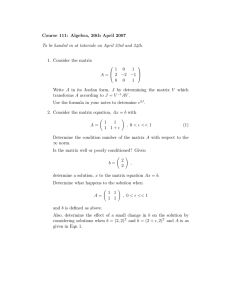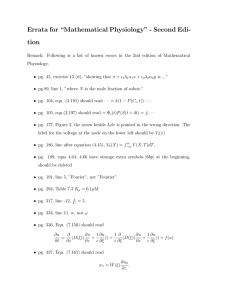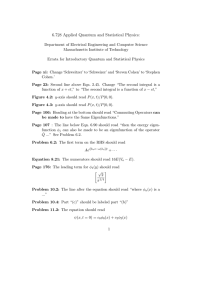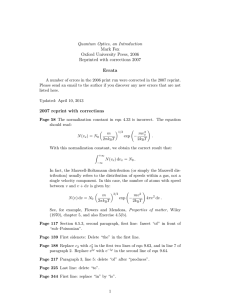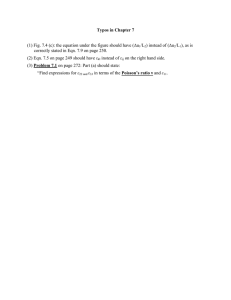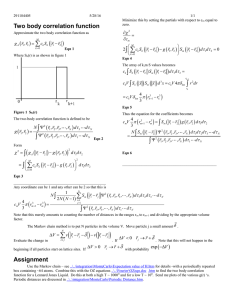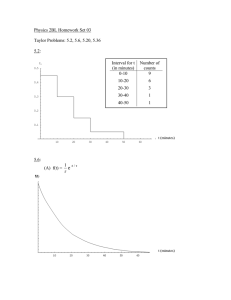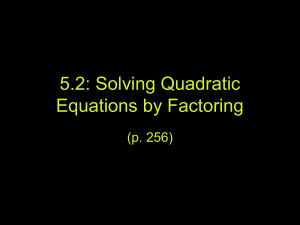Comment on Fermionic and Bosonic Pair-creation in an External Electric
advertisement
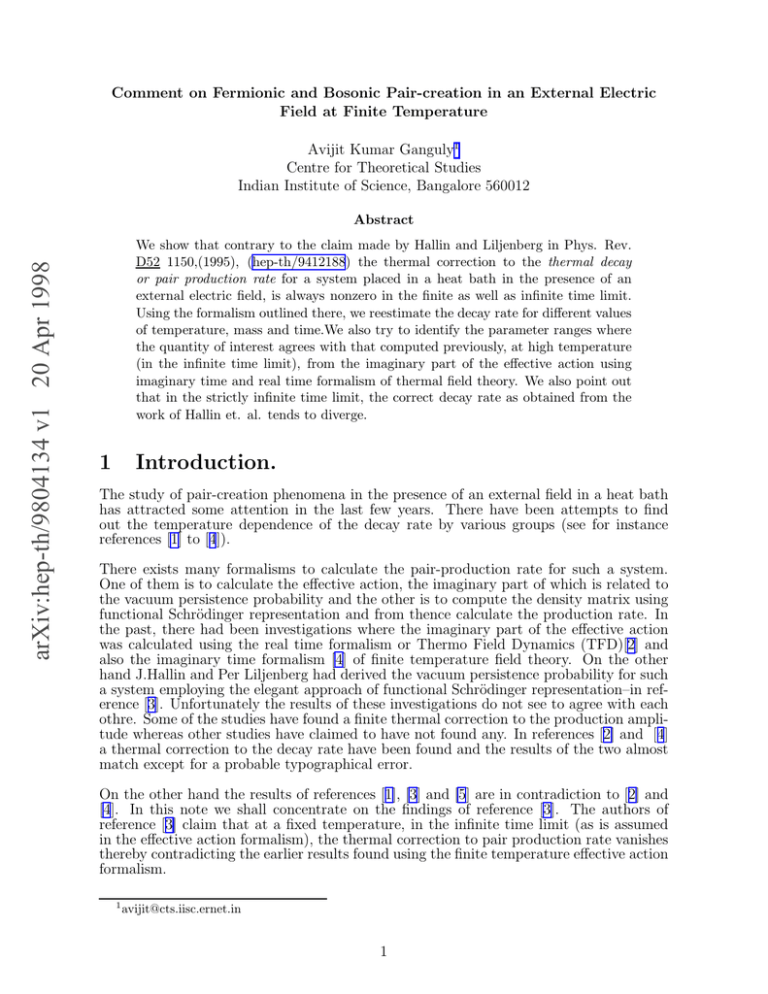
Comment on Fermionic and Bosonic Pair-creation in an External Electric Field at Finite Temperature Avijit Kumar Ganguly1 Centre for Theoretical Studies Indian Institute of Science, Bangalore 560012 arXiv:hep-th/9804134 v1 20 Apr 1998 Abstract We show that contrary to the claim made by Hallin and Liljenberg in Phys. Rev. D52 1150,(1995), (hep-th/9412188) the thermal correction to the thermal decay or pair production rate for a system placed in a heat bath in the presence of an external electric field, is always nonzero in the finite as well as infinite time limit. Using the formalism outlined there, we reestimate the decay rate for different values of temperature, mass and time.We also try to identify the parameter ranges where the quantity of interest agrees with that computed previously, at high temperature (in the infinite time limit), from the imaginary part of the effective action using imaginary time and real time formalism of thermal field theory. We also point out that in the strictly infinite time limit, the correct decay rate as obtained from the work of Hallin et. al. tends to diverge. 1 Introduction. The study of pair-creation phenomena in the presence of an external field in a heat bath has attracted some attention in the last few years. There have been attempts to find out the temperature dependence of the decay rate by various groups (see for instance references [1] to [4]). There exists many formalisms to calculate the pair-production rate for such a system. One of them is to calculate the effective action, the imaginary part of which is related to the vacuum persistence probability and the other is to compute the density matrix using functional Schrödinger representation and from thence calculate the production rate. In the past, there had been investigations where the imaginary part of the effective action was calculated using the real time formalism or Thermo Field Dynamics (TFD)[2] and also the imaginary time formalism [4] of finite temperature field theory. On the other hand J.Hallin and Per Liljenberg had derived the vacuum persistence probability for such a system employing the elegant approach of functional Schrödinger representation–in reference [3]. Unfortunately the results of these investigations do not see to agree with each othre. Some of the studies have found a finite thermal correction to the production amplitude whereas other studies have claimed to have not found any. In references [2] and [4] a thermal correction to the decay rate have been found and the results of the two almost match except for a probable typographical error. On the other hand the results of references [1], [3] and [5] are in contradiction to [2] and [4]. In this note we shall concentrate on the findings of reference [3]. The authors of reference [3] claim that at a fixed temperature, in the infinite time limit (as is assumed in the effective action formalism), the thermal correction to pair production rate vanishes thereby contradicting the earlier results found using the finite temperature effective action formalism. 1 avijit@cts.iisc.ernet.in 1 In this note, starting from eqn. [208] of reference [3] — obtained by the functional Schrödinger representation (for the fermionic case), we will show that there is a finite correction to the pair production rate, even in the very large time limit at any nonzero temperature. This is in direct contradiction to the results obtained in [3]. It must be noted here that though under some approximations this result reduces to the results obtained in reference [2] and [4] and we shall discuss the implications of that shortly. To be little more precise, we find that in the limit of very small time and high temperature the results of reference [3] matches with those of [2] and [4] found in the high temperature limit. On the other hand in the studies of [2] and [4] the production rate is calculated in the infinite time limit as performed in the strict thermodynamic sense. In this paper we will also point out that the production rate when properly computed, turns out to be a function of time and it tends to diverge once the infinite time limit is assumed. 2 Calculation In this section we start from the expression of probability P (0, 0; tf ), of finding the system with no fermion anti-fermion pairs in a state after a time t = tf , as is given in eqn. [208] of Hallin and Liljenberg [3], " 2V̄ P (0, 0; tf ) = exp C(β̄) + 2(2π 2 ) Z ∞ m̄2 1 + th(2 − 4e−πΛ ) dp̄ ln dΛ (1 + th)2 −t¯f 2 Z 0 3 # (1) For the benefit of the readers following reference [3] we re-introduce the notations as given there in [3] β̄ ω̄0g th = tanh , 2 " # Λ = (p¯1 )2 + (p¯2 )2 + (p¯3 )2 + (m̄)2 , m m̄ = √ , eE ω̄0g = V̄ = V (eE)3/2 , t¯f = tf (eE)1/2 , q Λ + (p̄3 + t¯f )2 p p̄ = √ eE √ β̄ = β eE. (2) With these definitions eqn.[1] can easily be cast in the following form " V̄ P (0, 0; tf ) = exp C(β̄) + (2π)2 Z ∞ m̄2 " 4th dp̄ ln 1 − dΛ e−πΛ 2 (1 + th)2 −t¯f Z 0 3 ## . (3) Since the quantity inside the logarithm in eqn.[3] is less than one we can expand the logarithm to arrive at # Z 0 i h V̄ Z ∞ 2β̄ω0 g 3 −πΛ . dp̄ 1 − e dΛe P (0, 0; tf ) = exp C(β̄) − (2π)2 m̄2 −t¯f 2 " (4) The expression for vacuum persistence probability, in the Schwinger sense [6] is obtained from the eqn.[1] as lnP (0, 0, tf ) . tf →∞ V tf W = lim (5) In [3] the infinite time limit was taken inside the integrand before carrying out the integration to find out the explicit tf dependence of the resulting expression. Though in some 2 cases this procedure might give identical result with the case where the limit is taken afterwards, here it does not seem to be so. Therefore, in order to compute the production rate W, unlike the authors of [3], we shall evaluate the integral retaining the explicit tf dependence before dividing it by tf and finally taking the limit tf → ∞. In order to simplify the situation a bit, from now on, we will work for a while with the integral inside eqn.[4]. It is given by, Z ∞ m̄2 dΛe −πΛ Z 0 −t¯f 3 2β̄ω0 g h i dp̄ 1 − e 2 = Z ∞ dΛe −πΛ m̄2 Z 0 3 dp̄ − 2 −t¯f Z ∞ m̄2 dΛe −πΛ Z 0 −t¯f 2 h dp̄3 g i e2β̄ω0 . (6) The first integral here gives the zero temperature Schwinger pair production probability and since the controversy in the literature is about the finite temperature piece we will ¯g concentrate only on q the second term in eqn.[6]. In the second integral the quantity ω0 g is given by ω̄0 = Λ + (p̄3 + t¯f )2 and it also appears in the exponent thus making the evaluation with exact tf dependence more difficult. Therefore to circumvent this difficulty we propose to rewrite the exponential using an integral transform of the following form [7] 2 √ e−α s α = √ 2 π Z ∞ 0 α2 e−us− 4u Now if we identify 2β̄ with α and the quantity ω¯0 g as β̄ ¯g e−β̄ ω0 = √ 2 π Z ∞ e−u[Λ+(p̄ du 3 u2 √ 3 +t¯ )2 f 0 (7) . s, we can write ]− β̄4u du . 3 u2 2 (8) With the aid of eqn.[8], we obtain from the second integral (eqn. [6]) upon performing the Λ integration β̄ I = √ π Z 0 −t¯f dp̄ 3 Z ∞ 0 β̄ 2 = √ e−m̄ π π Z du u 0 −t¯f dp̄ 3 3 2 Z ∞ m̄2 Z ∞ dΛe−Λ(π+u) e−u[(p̄ du e−u[m̄ 2 +(p̄3 +t¯ )2 f 3 u2 0 (π + u) 3 +t¯ )2 f 2 ]− β̄4u 2 ]− β̄4u . (9) Hereafter one can interchange the order of the integrations and carry out the p̄3 integration first. Upon performing √ this integration the resulting expression can be cast in the form of an error function with u × t̄f as its argument. Rewriting the error function as a series we obtain Z ∞ β̄ −m̄2 π X (t̄f )2k−1 (−1)k+1 ∞ duu(2k−5)/2 −um̄2 − β̄ 2 4u √ e I= (10) e π (2k − 1) (k − 1)! u + π 0 k=1 In order to write the pair production rate in a more compact form, we make the following change of variables u → z( β̄2 )2 in eqn.[10] and use the definition of pair production rate as given in eqn.[5] without taking the limit tf → ∞ before hand. And the resulting expression is, 2k−2 ∞ t̄f β̄ (−1)k+1 Z ∞ dzz (2k−5)/2 −z((β̄ m̄)/2)2 − 1 eE 2 −m̄2 π X z. √ e W = 2 e z π β (2π)2 π (2k − 1) (k − 1)! + 0 2 k=1 4 β̄ 2 This follows from the definition of the Bessel function. 3 (11) It can be seen from eqn.[11] that for any nonzero value of tf the pair production rate, contrary to the claim made in [3], is always nonzero. At zero temperature, i.e, when β = ∞, eqn.[11] goes to zero because of the (β)2 sitting in the exponent. And it conforms to our general expectation that as temperature tends to zero the temperature dependent correction to the rate should also vanish. On the other hand at a nonzero temperature, in the thermodynamic sense, as tf → ∞ the rate becomes divergent. This is an unique feature that comes out of the treatment of reference [3]. This is the main result of this paper. In the remaining portion of the paper we shall try to evaluate this expression numerically for different values of the parameters and write down the approximate analytic forms for each of these cases. 3 Discussion and Results In this section we evaluate W for three different values of the parameters namely (a) tf ≪ 1, m̄ ≪ 1 and β̄ ∼ O(1) or little more, (b) t̄f ≫ 1 but β̄ t¯f ≪ 1 and m̄ ≪ 1 and lastly (c) both β̄ and m̄ are ≪ 1 but t̄f ≫ 1. In the last case we would vary t̄f to show how W changes with its variation. We shall start with case (a) and then move over to the other two cases. In order to derive an approximate analytical form for W for this case we start from eqn.[9] instead of eqn.[11] as given in this text. Since in this case both tf and m̄ are assumed to be ≪ 1 and q the parameter β is of the order of one or slightly more, the quantity β̄ [m̄2 + (p̄3 + t¯f )2 ] is very small. Since the integral there varies from 0 to ∞ we would like to approximate the quantity (u + π) in the denominator by u to arrive at β̄ 2 √ e−m̄ π π Z 0 dp̄3 Z ∞ du −u[m̄ 5 e 2 +(p̄3 +t¯ )2 f 2 ]− β̄4u . (12) u2 Now we can perform the uν integration by using the formula for modified Bessel-function, h √ i h i R ∞ ν−1 −uγ− δ δ 2 u du = 2 e K 2 δγ . And using this form of the modified Bessel funcν 0 u γ tion eqn.[12] now comes out to be −t¯f 0 β̄ −m̄2 π Z 0 β̄ 2 √ e dp̄3 2 π [m̄2 + (p̄3 + t¯f )2 ] −t¯f !− 3 4 K− 3 2β̄ 2 q [m̄2 + (p̄3 + t¯f )2 ] . (13) For the range of parameters that we are interested in the argument of the modified Besselfunction tends to be very small. In this limit one can replace the modified Bessel-function Γ( 3 ) by its approximate form, K 3 (z) ≈ 21 z 23 . Using this relation eqn.[9] becomes 2 (2)2 β̄ −m̄2 π Z 0 β̄ 2 I = √ e dp̄3 2 π [m̄2 + (p̄3 + t¯f )2 ] −t¯f 2 t¯f e−m̄ π = 2β̄ 2 !− 3 4 K− 3 2β̄ 2 q [m̄2 + (p̄3 + t¯f )2 ] (14) For m̄ ≪ 1 the exponential can be approximated by ≈ 1. Hence the pair production rate in this limit, (using eqn.[5]) turns out to be, eET 2 . W ≈ 8π 2 4 (15) We have also evaluated, numerically, the pair-production rate from eqn.[11] for t̄f = 10−3 , with m̄ = 10−2 and have plotted it in figure [1]. It shows the behavior of W as one moves from low temperature to high temperature. It can be seen from the curve that the general trend qualitatively agrees with that given by eqn.[15]. As has already been mentioned in the beginning, apart from the numerical factors, this result agrees with that of reference [[2]] and [[4]] obtained in the high temperature and infinite time limit from the imaginary part of the thermal effective action. 35 30 25 Rate 20 15 10 5 0 0.01 0.025 0.04 0.055 0.07 0.085 0.1 Temperature Figure 1: Production rate vs temperature for tf = 1.0 × 10−3 and m̄ = 1.0 × 10−2 . Having discussed the case for t̄f ≪ 1 and m̄ ≪ 1, we will try to evaluate the pair production rate for t̄f ≫ 1 but β̄ t̄f ≪ 1 and m̄ ≪ 1. In order to do that, it will be convenient if we proceed from eqn.[11]. The first important thing to notice here is, as β̄ t¯f ≪ 1, the dominant contribution to the quantity of our interest comes from the first term in the summation. Hence, for the dominant contribution, it is sufficient to retain the k = 1 term where W can be approximated by 2(eE) 2 √ 2 e−m̄ π W ≈ 2 (2π) πβ Z ∞ 0 3 z − 2 dz − (m̄β̄)2 z− 1 z e 4 . z + βπ2 4 (16) Since the dominant contribution to the exponential comes from z ≈ ( β̄2m̄ ), which for the parameter range of our interest turns out to be quite large, we will proceed as before by approximating the denominator by z and then carrying out the z integration using the modified Bessel function of fractional order. On using the exact form of the Bessel 5 function eqn.[16] approximately comes out to be W ≈ (eE) −m̄2 π −(m̄β̄) e e . (2π)2 β 2 (17) We have estimated W numerically for m̄ = 10−6 and t̄f = 10−3 for various values of temperature ranging from 106 to 107 and have plotted them in figure [2]. It can be seen that the shape of the curve is basically due to the function e−(m̄β̄) as is given in eqn.[17]. 0.0006343 0.00063425 Rate 0.0006342 0.00063415 0.0006341 0.00063405 1e+06 2e+06 3e+06 4e+06 5e+06 6e+06 7e+06 8e+06 9e+06 1e+07 Temperature Figure 2: Production rate vs temperature for tf = 1.0 × 103 , m̄ = 1.d × 10−6 Lastly in figure [3] we have plotted W for β̄ = 10−4 and m̄ = 10−6 as a function of tf , ranging from 100 to 101 in arbitrary units. One can see from this curve that as time tf increases W also keeps on increasing. So in the strict thermodynamic limit as tf → ∞ the W would become divergent. 4 Conclusion Starting from eqn.[208] of ref.[3] we have shown that for a fermionic system, contrary to the claim made there (i.e. in [3]), at any non-zero temperature there is a finite correction to Schwinger’s pair production rate for any value of tf .It is shown that the final expression (i.e. eqn.[11]) comes as a power series in β̄ t̄f . Though for small values of β̄ and t̄f , this expression seems to be finite, but in the proper thermodynamic sense it is not. Since for realistic situations β̄ can never be zero, on the otherhand t̄f in principle can approach infinity, hence in the infinite time limit, the quantity W tends to diverge. The reason behind this apparently contradictory results seems to depend on how one takes the limit tf → ∞.In our view one should first carry out all the integrations and write down the final result as a function of tf , before taking the limit tf → ∞. Though we have carried out this detailed exercise for fermions only but in principle this can be extended for Bosons too. 6 We would like to mention here that the same quantity obtained using the finite temperature effective action formalism ( where infinite time limit is implicitly assumed) using both Thermo Field Dynamics and imaginary time formalisms ( see e.g. [2] and [4]) yields a nonzero finite result. In view of the previous results we find this corrected result of reference [3]to be quite amazing and in our view this deserves further study. Particularly one should try to understand why the different formalisms are giving different answers and which one of them is correct. But in case the corrected result of reference [3] which is obtained through the elegant formalism of Functional Schrödinger Representation turns out to be right (though we have some reservatio ns about it), it can certainly be used to estimate the thermal contribution to the soft processes dominated production mechanisms in the pre-equilibrium Quark Gluon Plasma production phase of relativistic heavy ion collisions, at the SPS and RHIC. 7e+41 6.5e+41 6e+41 5.5e+41 Rate 5e+41 4.5e+41 4e+41 3.5e+41 3e+41 2.5e+41 2e+41 1.5e+41 100 100.1 100.2 100.3 100.4 100.5 100.6 100.7 100.8 100.9 101 Time (t_f) Figure 3: Production rate vs tf for Temperature= 1.0 × 10−4 , m̄ = 1.d × 10−6 5 Acknowledgment Its a pleasure to thank Sanjay Jain and Apoorva Patel for many interesting discussions and encouragements and very useful suggestions made during the course of this work. The Author would also like to thank S. Konar, for the help rendered during the preparation of this manuscript. References 7 [1] P.H. Cox, W.S. Hellman and A. Yildiz, Ann. Phys.(N.Y.) 154, 211, (1984) [2] M. Loewe and J.C. Rojas, Phys. Rev. D46,2689, (1992) [3] Joakim Hallin and Per Liljenberg, Phys. Rev. D52 1150,(1995) [4] A. K. Ganguly, P.K.Kaw and J.C.Parikh, Phys. Rev. C51 (1995) 2091. [5] P. Elmfors and B.-S.Skagerstam, Phys. Lett. B 348, 141, (1995). [6] J. Schwinger, Phys. Rev. 82.664(1951). [7] Dingle, Asymptotic expansions: Their derivation and interpretation Academic Press ( London and New York, 1973) 8
